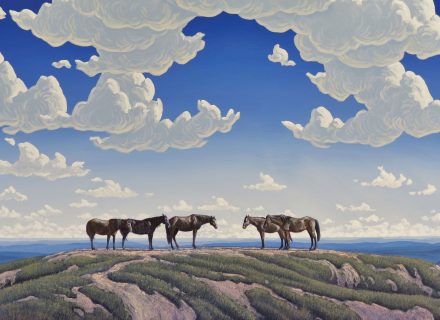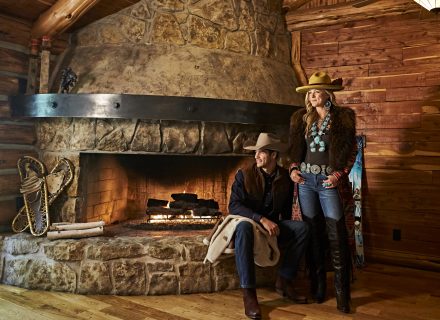Brooks & Dunn are still humble after all these years.
So far, this year’s been one for the books for Brooks & Dunn. In April, they released their first album together in 12 years. In March, they were inducted into the Country Music Hall of Fame. And in August, that Hall of Fame and Museum opened a Brooks & Dunn exhibit to celebrate their nearly 30-year reign as country music’s best-selling duo. It’s the kind of feat Kix Brooks and Ronnie Dunn never saw coming.
One of the duo’s first hits from the early 1990s — “Boot Scootin’ Boogie,” inspired by the Tulsa City Limits nightclub --— paints a picture of guys who hit the door running when it’s quittin’ time. But if you ask Brooks or Dunn, there’s no such thing as quittin’ time.
Right after their Hall of Fame induction ceremony, Brooks & Dunn sat down with Cowboys & Indians in a dressing room right outside the revered rotunda to talk about the series of events that brought them here. It comes down to their cowboy work ethic: Take a deep seat, a short rein, and get after it.
For example, when Brooks & Dunn took home the Academy of Country Music’s award for entertainer of the year in 1996, they were the first duo to do so in the history of the grand prize. You’d think that would give them some bragging rights.

“Our reaction to that win was, ‘Damn, we did that.’ We were shell shocked. It hit us so hard that we really didn’t have a clue. In fact, after we got up there and mumbled some thanks, we both walked off the stage in different directions,” Dunn tells C&I.
They were ill-prepared on purpose, Brooks adds. “It always seems awkward to me when someone pulls a piece of paper out of their pocket. Even if you think there’s an outside chance of a win, that you’d be that prepared,” he says, laughing. “We never even discussed winning, much less who we’d even thank. That always seemed too presumptuous. Like, ‘Why us?’ ”
The two men have clung tight to that humble mind-set ever since.
Cowboys & Indians: So you truly had no expectations going into that 1996 ACM Award show, even though you’d amassed so many hits since your debut album in 1991?
Ronnie Dunn: No, because it was all so new. And it all happened so fast. We weren’t expecting any of that. The same week we met, we wrote two songs. And next thing we know, we thought we were just seat fillers at the ACMs, and then we won. This didn’t make any sense. And it still doesn’t.
C&I: But eventually you must’ve felt like you’d earned the good things that were coming your way.
Kix Brooks: We never trusted our success. We’d been kicking around doing solo deals for so long, then at 36 and 38 years old we were put together. To think we’d have a 25-year career in front of us? We’d both been in the business long enough to know that s**t doesn’t happen. But then our first single, “Brand New Man,” was such a success, we were like, Well, that was weird.
C&I: So you assumed it was some kind of country music fluke?
Brooks: Yes. And even though we knew we’d obviously make another record, we knew that ain’t gonna happen again. But then song after single and single after song, things just kept going. Both of us were always thinking it was about to be over.
Dunn: I remember talking with my wife when we first moved to Nashville, about our financial goal. And if the dream came true, and we hit a certain amount, then we were gonna go back to Oklahoma.
Brooks: We were just here to get what we came for, knowing it doesn’t last.

C&I: And yet, it’s been 23 years since that validation from the ACM. Now do you feel established?
Dunn: Maybe, but only because I never had a Plan B.
C&I: Meaning, regardless of the fame and riches, being a country singer was the only plan you had?
Dunn: Yes, even when that meant living through some sheer poverty. I slept on a buddy’s floor for a year and a half when I moved to Tulsa, after I’d dropped out of college. Back then, you’d hustle to get club owners to let you play. I had no goal other than just scraping up anything I could get.
Brooks: Same here. I had no money. I could always make some beer money playing in some bar in New Orleans. But once I decided to move to Nashville, it was the only place I’d been where I couldn’t make a living making music. I was playing at the Bluebird [Cafe] for nothing. And me and David Lee Murphy would play at the Springwater Supper Club, a little-a*s beer joint, for $30 a night. My wife and I lived off the money we saved in a coffee can.
C&I: But eventually, the money started rolling in. What did you do with all of it initially?
Dunn: Nothing, really. Because at the time, we had a manager we called Captain Downside. He had all these horror stories about artists who’d had hits and spent all their money. So we were careful not to spend money, and we stayed way under the radar on that. But I remember one of the first indulgences I had was when I bought a used, ugly, gray diesel Mercedes-Benz. Then I was too embarrassed to drive around town in a Mercedes-Benz, so I sold it.
C&I: So if you weren’t in it for the money, what were you earning in those early years?
Brooks: I had so much big fun when I got to Nashville. I didn’t have s**t for money, but I was partying all the time. Just staying up to our necks in trouble. At 5 every day, you’d meet at publishing houses and play whatever half-ass, piece-of-s**t song you’d written that day. Then the greats would play what they wrote that day, and your eyes would roll back in your head and you’d go, “I’ve gotta work harder.” I didn’t respect Nashville songwriters until I got here. Those guys were like Hemingway. They’d break your heart if you give them a chance. So I have no regrets. I look back on all those times fondly.
C&I: The Reboot album you released in April has 12 of your biggest songs recorded as duets with the newest singers from this modern era of country. Kacey Musgraves, Jon Pardi, Thomas Rhett, Cody Johnson, Kane Brown, and more. Your music was a heavy influence on those artists. But who influenced you? Who was your Brooks & Dunn?
Dunn: Merle Haggard, George Jones, and then later, the Eagles.
Brooks: Johnny Cash, Roger Miller, and Hank Williams especially. That was just as cool as it got. I was also a huge fan of Jerry Jeff Walker, Leon Russell, and Asleep at the Wheel. And of course the Eagles. Song after song, good grief.

C&I: Another coveted honor for you this year was when your Hall of Fame exhibit opened. What was it like to go down your own personal memory lane to collect all that B&D memorabilia?
Dunn: I feel much more humble now that they came and took all my stuff out of my house.
Brooks: I used to walk through my house, see all my awards, and be so proud of myself. But now it’s just like a regular house. We had to give it away, though, because you just can’t hang 20 years of a career in your house. There’s not room in any house for all of it.
C&I: Was the Hall of Fame induction something you saw coming? Like a benchmark you deserved after nearly three decades as a duo?
Dunn: Not at all. We’re still in a state of disbelief. The best way to stay out of that head game is not to expect it, and keep your mind on other things. If you want it all, the only way to get it all is to take one step at a time.
Brooks: You can’t ever think, It’s about time. All I ever hope for is to wake up tomorrow and write a good song. This kind of thing may be in the back of your mind, but if money and the Hall of Fame are your goals, I don’t see how you ever achieve anything. You need to take small steps.
UP NEXT: Jon Pardi: The Heartache Kid
Find out more about the exhibit Brooks & Dunn: Kings of Neon by visiting countrymusichalloffame.org.
Brooks & Dunn, Kane Brown, and Jon Pardi were photographed on location at Robert’s Western World in Nashville. Special thanks to Emily Ann Cousins and the Robert’s staff. Photography: Robby Klein. Photographic assistance: Vic Bonvicini, Andrés Martinez, Chris Parsons. Grooming: Katrina Brooks (for Jon Pardi), Debbie Dover Hall (for Brooks & Dunn), Cindy Rich (for Kane Brown). Styling: John Murphy (for Jon Pardi), David Thomas (for Kane Brown), Payton Dale (styling assistance for Kane Brown)
Photography: (Middle image) Miller Mobley/Courtesy The Greenroom
From the October 2019 issue.

















